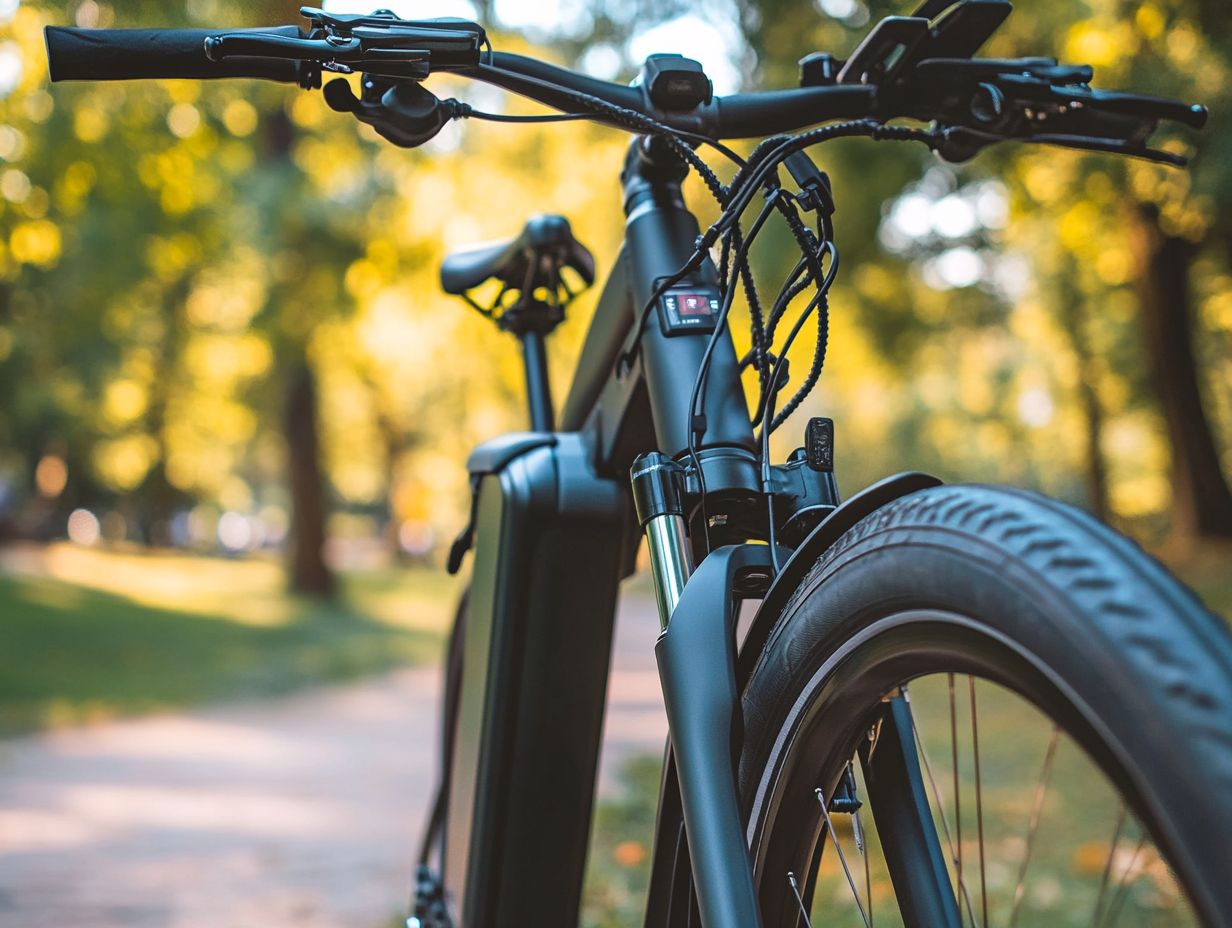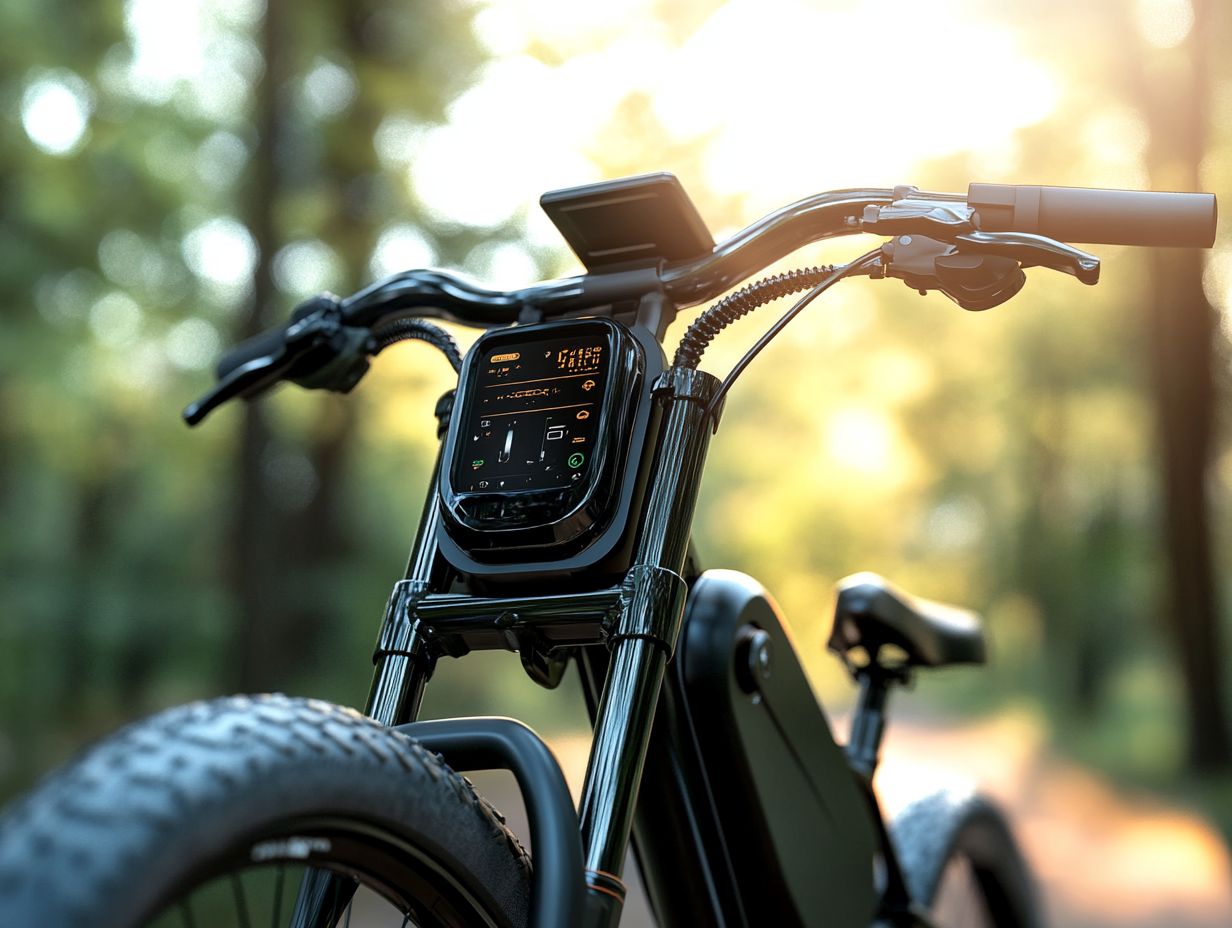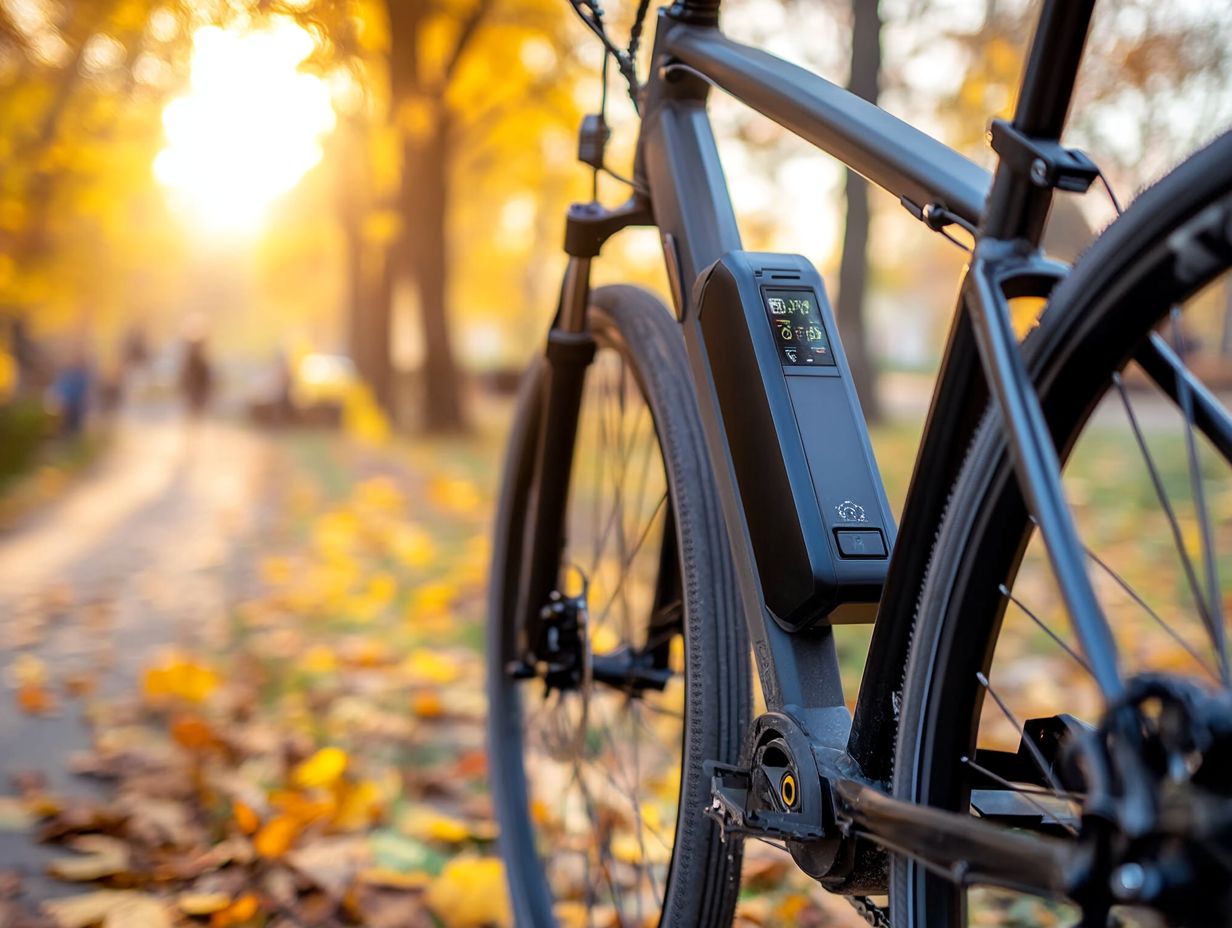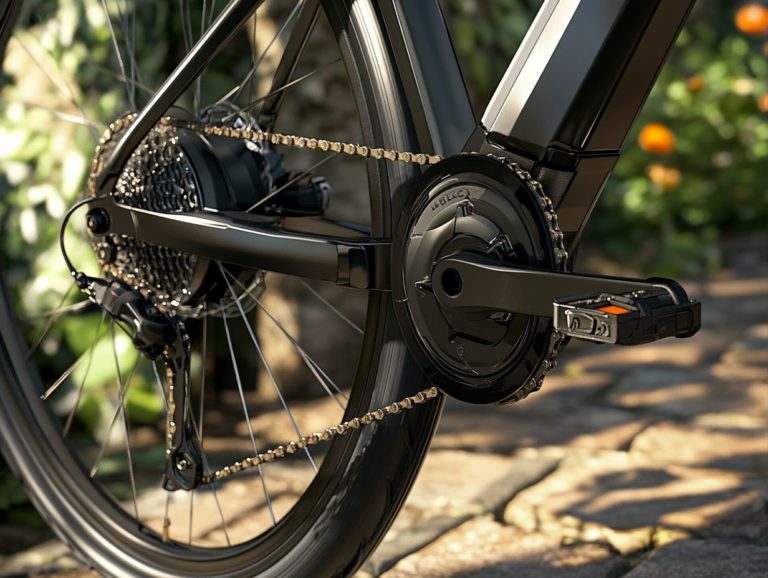What are the Main Features of Electric Bicycles?
Electric bicycles, also known as e-bikes, are redefining your approach to commuting and leisure activities.
By merging the convenience of traditional biking with electric assistance, these bikes offer an exhilarating ride while championing sustainability. This guide delves into the diverse types of electric bicycles available, highlighting their advantages for both the environment and your personal health.
You ll discover essential factors to consider before making a purchase, such as battery capacity and charging time, alongside maintenance tips and budgeting strategies to ensure you are fully prepared to choose and care for your electric bike.
Whether you re a seasoned cyclist or just starting on your biking journey, this information will empower you to navigate the thrilling world of electric bicycles with confidence.
Contents
- Key Takeaways:
- Types of Electric Bicycles
- Benefits of Electric Bicycles
- Factors to Consider When Buying an Electric Bicycle
- Maintenance and Care for Electric Bicycles
- Cost and Affordability of Electric Bicycles
- Frequently Asked Questions
- Curious about the main features of electric bicycles? Let’s dive in!
- What is the difference between electric bicycles and traditional bicycles?
- Do electric bicycles require a license to ride?
- What is the range of an electric bicycle?
- Can I still pedal an electric bicycle?
- Are electric bicycles environmentally friendly?
Key Takeaways:

- Electric bicycles are a type of bicycle that uses an electric motor to assist with pedaling, making it easier to ride longer distances and tackle hilly terrain.
- There are different types of electric bicycles based on their classification and differences in motor power, speed, and pedal assist levels.
- When considering purchasing an electric bicycle, key features to look for include battery type and capacity, motor power, and pedal assist options.
What are Electric Bicycles?
Electric bicycles, or e-bikes as you may know them, are the exciting blend of traditional cycling and electric propulsion, making them an increasingly preferred option for both commuters and leisure riders. Powered by lithium-ion batteries, these innovative machines come equipped with various motor types think hub motors and mid-drive motors that elevate their efficiency and performance.
As the world shifts towards eco-friendly transport and convenient commuting solutions, e-bikes have emerged as a key player in urban mobility.
You ll find that the design of these bicycles often includes ergonomic frames aimed at providing comfort during your rides, catering to a range of user preferences. With different models tailored for specific needs, from city commuting to off-road escapades, e-bikes offer versatility that suits many lifestyles.
Some popular options even include folding models for effortless storage, while others are tailored for speed and fitness enthusiasts.
And let s not overlook the integration of smart technology, which allows you to monitor battery life and adjust settings on-the-go. This feature enhances your riding experience, making electric bicycles a compelling choice for those who seek innovative and sustainable transportation solutions.
Types of Electric Bicycles
When exploring the world of electric bicycles, you’ll discover a diverse array of options tailored to different riding styles and purposes. Understanding these choices is crucial for maximizing your experience.
For instance, e-mountain bikes are expertly designed to conquer rugged terrains, while electric road bikes cater to speed enthusiasts craving a thrilling ride. If stability is your priority, versatile electric tricycles are an excellent choice.
Additionally, consider high-capacity cargo bikes, which excel in handling substantial loads, making them ideal for transporting goods or enjoying a hassle-free commute.
Classifications and Differences
Electric bicycles can be categorized in various ways, including motor types, power output, and user features. Each of these factors significantly impacts your riding experience and efficiency.
The two primary motor types are hub motors and mid-drive motors. Hub motors are known for their straightforward design, making them perfect for those seeking simplicity. In contrast, mid-drive motors excel in how weight is balanced and torque, enhancing performance on diverse terrains.
E-bikes also offer options for pedal assist or throttle control, giving you the flexibility to engage with electric propulsion in a way that suits your journey.
Understanding these classifications helps you make informed decisions tailored to your needs. For example, if you’re looking for a low-maintenance ride ideal for casual commuting on flat surfaces, hub motors typically perform best. On the other hand, mid-drive motors are excellent for climbing, making them a better choice for hilly areas.
Power outputs range from 250W to 750W, influencing acceleration and speed. Various assistance modes let you customize your riding experience, whether you prefer leisurely outings or intense workouts. By carefully evaluating these factors, you can optimize both your comfort and overall performance as you navigate your adventures.
Benefits of Electric Bicycles

Don t miss out on the incredible advantages of electric bicycles they’re transforming how we commute! They offer a blend of environmental benefits, health perks, and economic savings, positioning them as an ideal choice in today s eco-conscious world.
When you choose e-bikes over traditional cars, you re not just cutting down on your carbon footprint; you re also embracing a more active lifestyle.
Furthermore, e-bikes serve as a smart alternative for urban commuting, allowing you to glide through traffic effortlessly and arrive at your destinations quickly.
Environmental and Health Advantages
Electric bicycles are game changers for the environment! They reduce your reliance on fossil fuels and lower greenhouse gas emissions, contributing to a healthier planet.
They invite you to embrace an active lifestyle, allowing you to incorporate physical activity into your commute or enjoy leisurely rides.
With features like pedal assist, e-bikes enable you to tailor your effort, making cycling accessible for everyone, regardless of fitness level.
In cities like Amsterdam, where cycling infrastructure is robust, e-bikes have become increasingly popular. This shift has led to a noticeable decline in carbon emissions. A study from the European Cyclists’ Federation reveals that if more individuals embraced cycling, urban congestion-related emissions could be reduced by up to 30%.
Regular cycling has also been linked to a lower risk of chronic illnesses, significantly enhancing health and boosting public well-being. Research published in the Journal of Preventive Medicine highlights that frequent cyclists report higher energy levels and improved overall mental health.
This underscores the holistic advantages of integrating e-bikes into your daily routine.
Factors to Consider When Buying an Electric Bicycle
When you’re in the market for an electric bicycle, it s essential to weigh several critical factors to find the model that aligns perfectly with your needs and preferences.
Pay close attention to battery capacity, charging time, and the type of motor whether hub motors or mid-drive motors since these components significantly impact performance and usability.
Moreover, consider the ergonomics of the frame and the overall weight, as these elements play a crucial role in your comfort and handling while riding.
Now is the perfect time to explore electric bicycles and find the one that suits your lifestyle!
Key Features to Look for
When you re on the hunt for the perfect electric bicycle, like those with hydraulic disc brakes, there are several key features that can make your ride better and enhance your safety. Look for hydraulic disc brakes, which provide superior stopping power, built-in lights for visibility when it’s dark, and good suspension for a smoother ride across various terrains.
Also consider the bike’s weight, power output, and connectivity options that integrate displays and smartphone connectivity for a more interactive journey. These features ensure safety and meet your needs, whether you re an urban commuter, a weekend adventurer, or a mountain trail aficionado. Pay close attention to battery life and charging times, as they can significantly influence your long-distance excursions.
Comfort features like adjustable seating and ergonomic grips will enhance your overall enjoyment during extended rides. If versatility is key for you, unique specifications such as folding capabilities or all-terrain tires can be crucial for navigating daily travels or exploring rugged landscapes.
Maintenance and Care for Electric Bicycles

Proper maintenance and care for electric bicycles are vital for ensuring their longevity, optimal performance, and, most importantly, a safe riding experience.
You should regularly check the battery, keeping an eye on its capacity and charging cycles, as this is essential for the health of your e-bike. Routine cleaning is also important; clean the frame and drivetrain, and inspect the brake systems and tires to maintain your bicycle.
Taking time for maintenance means safer, smoother rides.
Tips and Best Practices
To keep your electric bicycle in peak condition, it’s essential to embrace some key tips and best practices for maintenance and care. Paying attention to these factors not only extends your bike s lifespan but also guarantees a safer and more enjoyable riding experience.
In terms of battery care, remember to store it in a cool, dry place during the off-season, steering clear of extreme temperatures that could compromise its efficiency. For cleaning, opt for mild soap and water to treat the frame and components, and avoid abrasive materials that might scratch those pristine surfaces.
Don t overlook regular safety checks. Inspect your lights and reflectors, and make sure all screws and bolts are tightened; these small steps can lead to significant improvements in performance. Using these proactive strategies, you can sidestep many common issues that often plague electric bicycles.
Cost and Affordability of Electric Bicycles
The cost and affordability of electric bicycles can vary significantly depending on the brand, features, and specifications. It’s crucial for you to consider your budget thoughtfully.
Prices can span from budget-friendly models with basic features to premium e-bikes boasting advanced technology and powerful motors. By grasping the long-term value of investing in an electric bicycle versus conventional transportation options, you can make a more informed decision that aligns with your needs, including understanding different types of electric bicycles.
Imagine cruising effortlessly through the city or tackling challenging trails with the right electric bike! Don’t wait start checking these features today!
Ready to find the perfect electric bicycle? Start your search now!
Comparing Prices and Budgeting
When you’re comparing prices of electric bicycles, it’s crucial to look beyond just the upfront costs. You should also consider the long-term value and savings that come with e-bikes. Budgeting for an electric bicycle means factoring in maintenance costs, battery replacements, and the potential savings on fuel and commuting expenses.
By exploring various price points and features, you can uncover cost-effective options that meet your needs without sacrificing quality.
Brand reputation, component quality, and available warranties significantly influence the overall pricing of electric bikes. Higher-end models often come with better gear setups and superior battery technology, making their higher price tags easier to justify.
In urban areas, you can reduce transportation costs, as e-bikes can frequently replace your car trips.
By carefully considering these points, you’ll make smart choices that align perfectly with your financial plans and riding preferences.
Frequently Asked Questions

Curious about the main features of electric bicycles? Let’s dive in!
Electric bicycles, also known as e-bikes, have gained popularity in recent years due to their many features. Some of the main features are:
- Removable batteries
- Multiple assistance levels
- Torque sensors help measure how much force you’re applying while pedaling.
What is the difference between electric bicycles and traditional bicycles?
The main difference between electric bicycles and traditional bicycles is the addition of an electric motor. This motor allows the rider to pedal with less effort and can also provide a boost to the bike’s speed.
Do electric bicycles require a license to ride?
In most countries, electric bicycles do not require a license to ride as they fall under the same category as traditional bicycles. However, it is always best to check your local laws and regulations.
What is the range of an electric bicycle?
The range of an electric bicycle varies depending on the model and battery capacity. On average, most electric bicycles can travel between 20-50 miles on a single charge.
Can I still pedal an electric bicycle?
Yes, electric bicycles still require pedaling to operate. The electric motor provides assistance, making it easier to pedal and allowing the rider to cover longer distances with less effort.
Are electric bicycles environmentally friendly?
Compared to traditional gas-powered vehicles, electric bicycles are much more environmentally friendly. They do not emit harmful pollutants and can be charged using renewable energy sources.
Considering an electric bicycle? Explore your options today and see how they can enhance your commuting experience!






